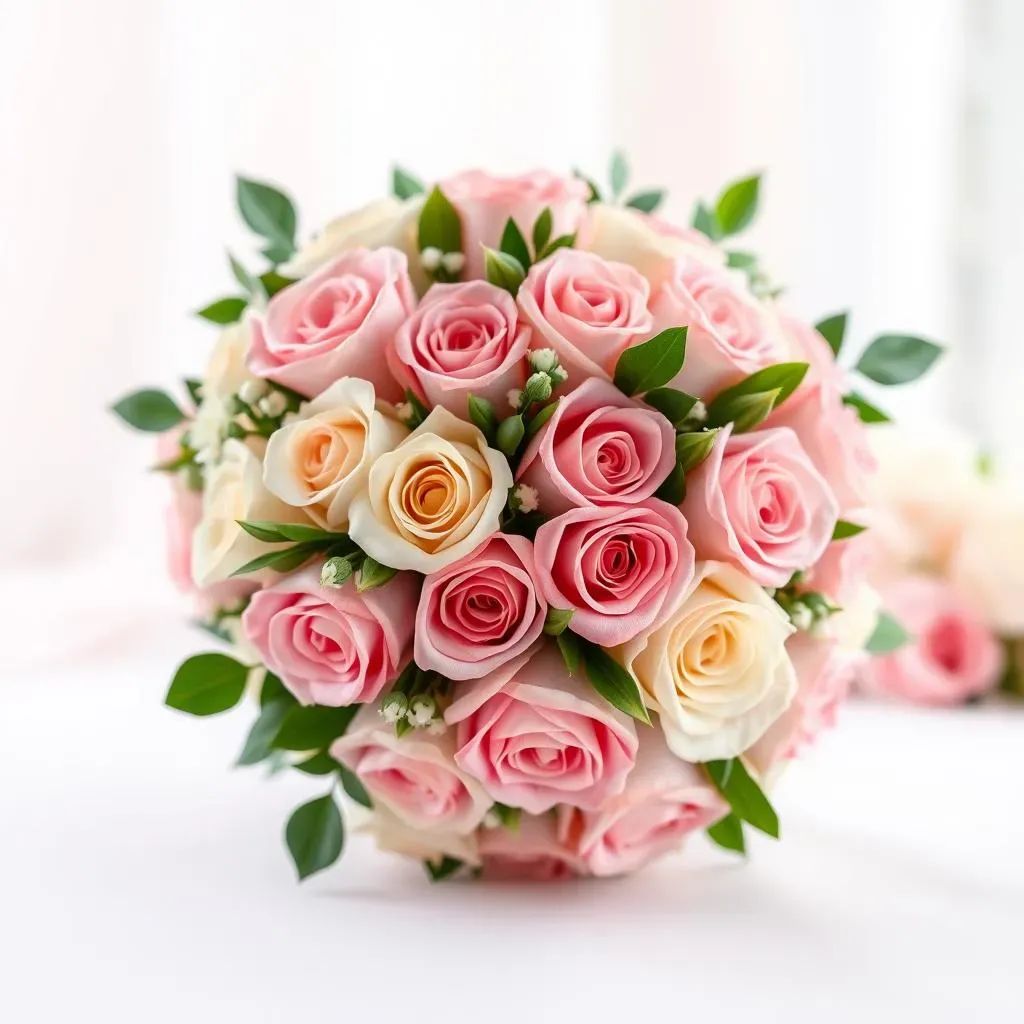Table of Contents
Planning a wedding is exciting, but choosing the perfect details can feel overwhelming. One of the most important decisions? Your wedding bouquet! And if you're dreaming of a romantic and elegant look, a pink and white rose wedding bouquet might be exactly what you need. This article is your complete guide to creating the perfect floral arrangement for your special day. We'll explore the diverse world of pink and white roses, helping you choose the varieties that best suit your style and wedding theme. We'll then walk you through the design process, offering tips and tricks for arranging a breathtaking bouquet, whether you're working with a florist or creating your own DIY masterpiece. Discover how to incorporate other flowers to complement your roses, adding depth and texture to your arrangement. Finally, we'll share advice on preserving your precious bouquet so you can cherish its beauty for years to come. Get ready to embark on a journey of floral inspiration as we delve into the art of crafting a stunning pink and white rose wedding bouquet – a symbol of your enduring love and commitment.
Choosing the Right Pink and White Roses for Your Bouquet
Choosing the Right Pink and White Roses for Your Bouquet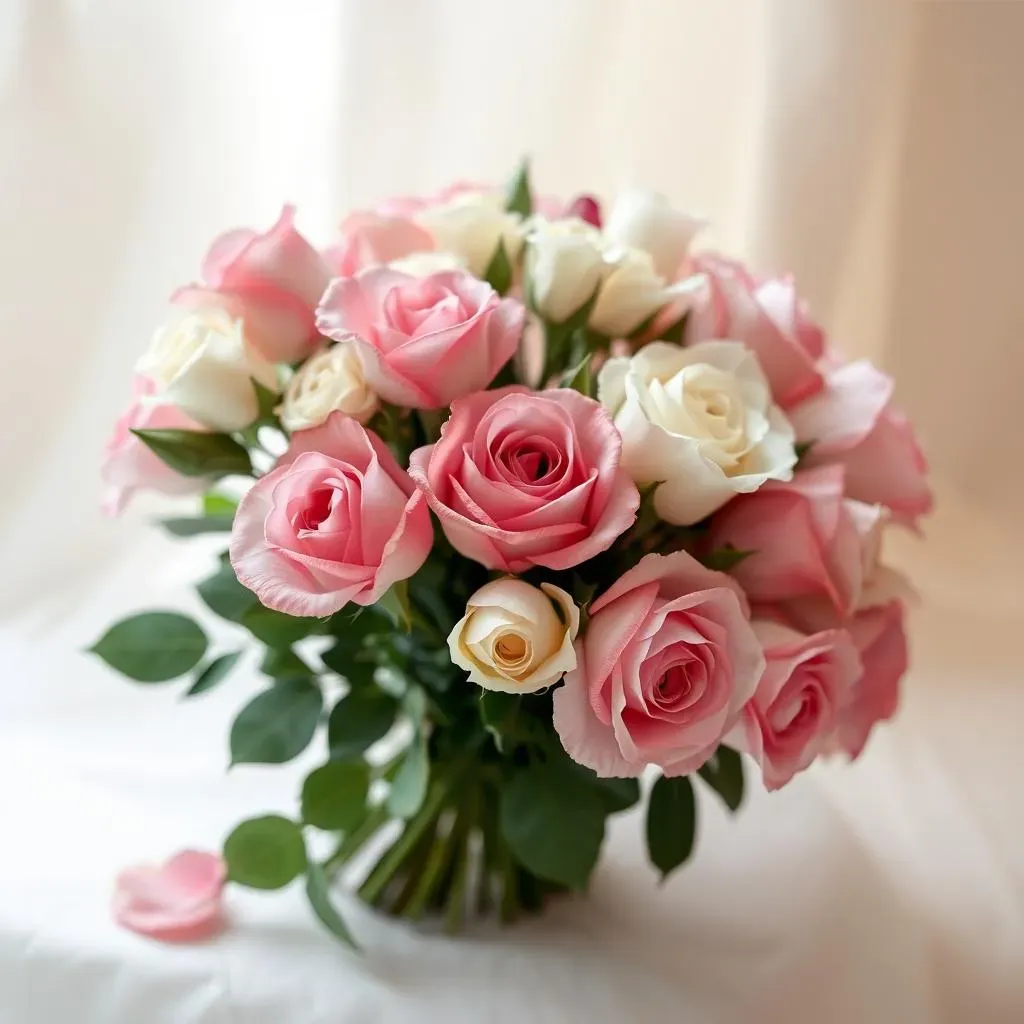
Rose Varieties: A World of Pink and White Hues
Picking the perfect roses for your bouquet is like choosing the perfect outfit – it needs to reflect your style and the overall vibe of your wedding. Think about the shades of pink and white you love. Are you drawn to soft blush pinks and creamy whites, or do you prefer bolder, deeper tones? Consider the season, too. Some roses bloom more readily in certain months. For instance, garden roses are stunning but might not be readily available in the dead of winter. David Austin roses, known for their old-fashioned charm, offer a wide range of romantic pink and white options. Don't be afraid to mix and match different types of roses to create a unique and layered look. Think about the shape and size of the blooms – do you prefer large, full-blown roses or smaller, more delicate ones? The possibilities are endless!
Remember that the size and shape of the rose will impact the overall look of your bouquet. A cascade bouquet, for example, looks stunning with long-stemmed roses, while a more compact bouquet might suit smaller, more tightly packed blooms. Don’t forget to consider the fragrance! Some roses have a strong, heady scent, while others are more subtly fragrant. This is a personal choice, but the scent can play a big part in the overall feel of your wedding.
Rose Type | Color Variations | Bloom Size |
|---|---|---|
Garden Rose | Wide range of pinks and whites | Large, full blooms |
David Austin Rose | Many shades of pink and white, often with a vintage feel | Medium to large blooms |
Spray Rose | Numerous pink and white options | Small, clustered blooms |
Considering Your Wedding Theme and Style
Your wedding theme will greatly influence the choice of roses. A rustic wedding might call for more informal roses with a natural, slightly less perfect look. A formal wedding, on the other hand, might benefit from the classic elegance of perfectly formed hybrid tea roses. Think about the overall color palette of your wedding. Do you want the roses to be the star of the show, or will they be complemented by other flowers and greenery? If you're using other flowers, choose roses that will harmonize with their colors and textures, creating a cohesive and visually appealing bouquet. Don't forget the practical aspects. Some roses are more durable than others, which is especially important if your wedding is outdoors or in a warm climate.
Imagine a beach wedding with soft pink roses complemented by sea-grasses and succulents. Contrast that with a glamorous ballroom wedding with lush, deep pink roses paired with opulent orchids and crystals. The right rose will enhance your chosen aesthetic, ensuring your bouquet perfectly reflects your personal style and the overall ambiance of your special day. Ultimately, the best roses for your bouquet are the ones that make you feel happy and excited! Choose roses that resonate with your personal taste and create a bouquet that truly reflects your unique style.
- Consider your wedding theme (rustic, formal, modern, etc.)
- Think about the overall color palette of your wedding
- Choose roses that complement other flowers and greenery
- Consider the durability of the roses, especially for outdoor weddings
Designing Your Dream Pink and White Rose Wedding Bouquet
Designing Your Dream Pink and White Rose Wedding Bouquet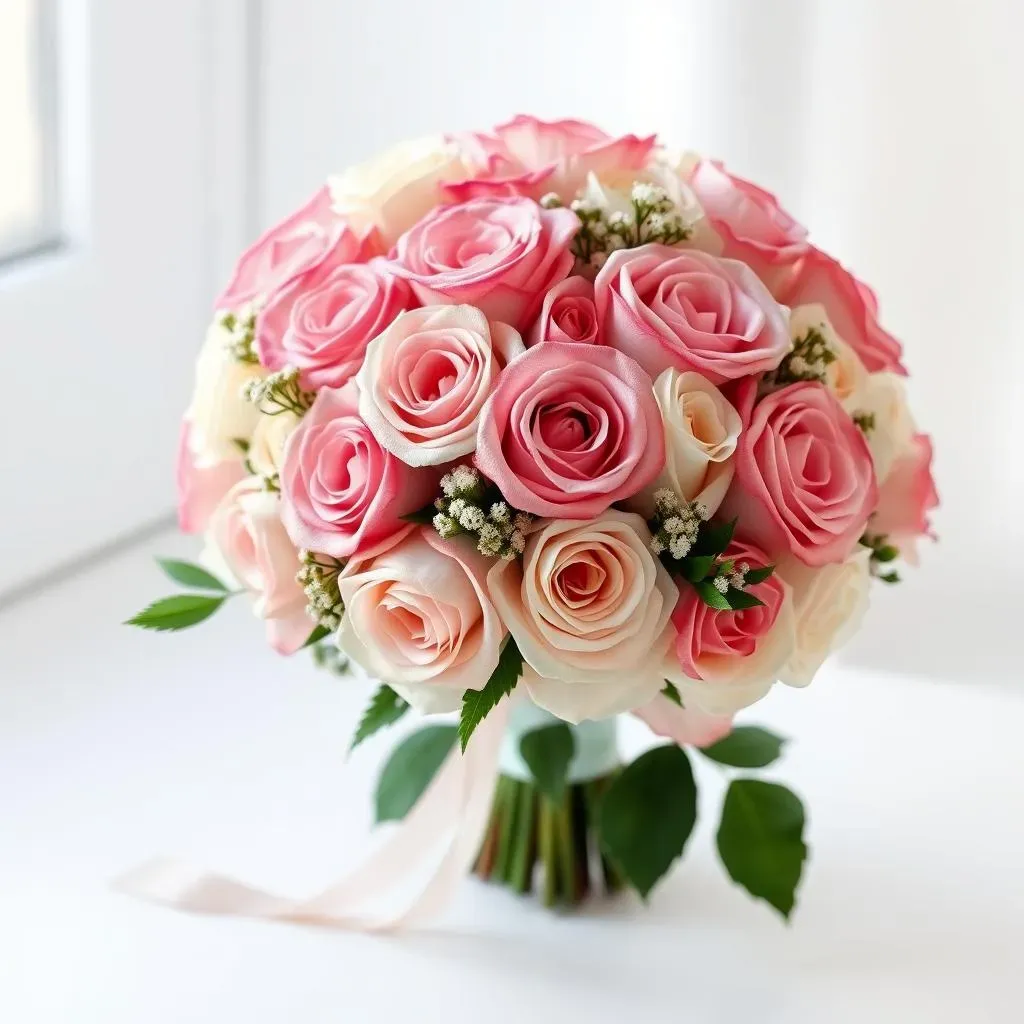
Choosing Your Bouquet Style
The first step in designing your dream bouquet is deciding on the overall style. Do you envision a classic round bouquet, a cascading bouquet that flows elegantly down your arm, a more modern hand-tied bouquet, or perhaps a whimsical posy? Each style lends itself to different arrangements and rose types. A round bouquet, for instance, is incredibly versatile and works well with a mix of rose sizes and other flowers. A cascading bouquet, on the other hand, typically features long-stemmed roses arranged in a dramatic, flowing design. Consider your dress, your wedding theme, and your personal preferences when making your choice. A simple, elegant gown might pair beautifully with a classic round bouquet, while a more bohemian dress might complement a loose, hand-tied arrangement.
Think about the overall shape and size you want your bouquet to be. A larger bouquet will make a bolder statement, while a smaller one can be more delicate and understated. The size of your bouquet should also be proportionate to your height and the style of your dress. Remember to consider the weight of the bouquet – you'll be carrying it for a significant portion of your wedding day, so you want something comfortable and manageable. A good florist can help you choose a style and size that's both beautiful and practical.
Bouquet Style | Description | Suitable Rose Types |
|---|---|---|
Round Bouquet | Classic and versatile, with a symmetrical shape | Garden roses, David Austin roses, spray roses |
Cascading Bouquet | Dramatic and flowing, with roses cascading down | Long-stemmed roses, often with trailing greenery |
Hand-Tied Bouquet | Loose and informal, with a natural, slightly undone look | Mix of rose types and other flowers |
Posy Bouquet | Small and compact, perfect for a more intimate wedding | Small roses, often with delicate filler flowers |
Incorporating Texture and Color
Once you've chosen your bouquet style, it's time to think about texture and color. Don't be afraid to mix different shades of pink and white roses to create depth and visual interest. You can also incorporate other flowers and greenery to add texture and contrast. Think about the different textures of the flowers – the velvety petals of a garden rose, the delicate texture of a spray rose, the feathery lightness of baby's breath. These different textures can add a lot of visual appeal to your bouquet. Consider adding greenery, like eucalyptus or ferns, to complement the roses and add a touch of natural beauty. Greenery also helps to balance the overall look of the bouquet and provide a pleasing contrast to the soft colors of the roses.
For example, you might combine blush pink garden roses with creamy white David Austin roses and add touches of greenery like eucalyptus or seeded eucalyptus. Or, you could pair deep pink spray roses with ivory roses and delicate sprigs of gypsophila (baby's breath). The possibilities are endless! Remember to consider the seasonality of the flowers you choose. Some flowers are only available at certain times of the year, so it's important to work with your florist to find flowers that are in season and readily available. A skilled florist can help you create a bouquet that is both beautiful and reflects the season of your wedding.
- Consider mixing different shades of pink and white
- Incorporate other flowers and greenery for texture and contrast
- Think about the different textures of the flowers (velvety, delicate, feathery)
- Use greenery to balance the look and add natural beauty
- Consider the seasonality of the flowers
Adding Finishing Touches
The finishing touches can truly elevate your bouquet from beautiful to breathtaking. Consider adding ribbons, lace, or other embellishments to complement your wedding theme and style. A simple satin ribbon in a coordinating color can add a touch of elegance, while a more rustic lace ribbon might be perfect for a bohemian wedding. You can also add small details, like crystals or pearls, to add a touch of sparkle and glamour. However, avoid overdoing it – less is often more when it comes to embellishments. The focus should remain on the beauty of the flowers themselves.
Think about the overall look you want to achieve. Do you want a classic, elegant bouquet, a more romantic and whimsical one, or something modern and minimalist? The finishing touches should enhance the overall style of your bouquet and create a cohesive and visually appealing look. Remember, the bouquet is an important part of your overall wedding aesthetic, so it should complement your dress, your venue, and the overall theme of your wedding. Work closely with your florist to create a bouquet that is not only beautiful but also reflects your personality and style.
Incorporating Other Flowers with Your Pink and White Roses
Incorporating Other Flowers with Your Pink and White Roses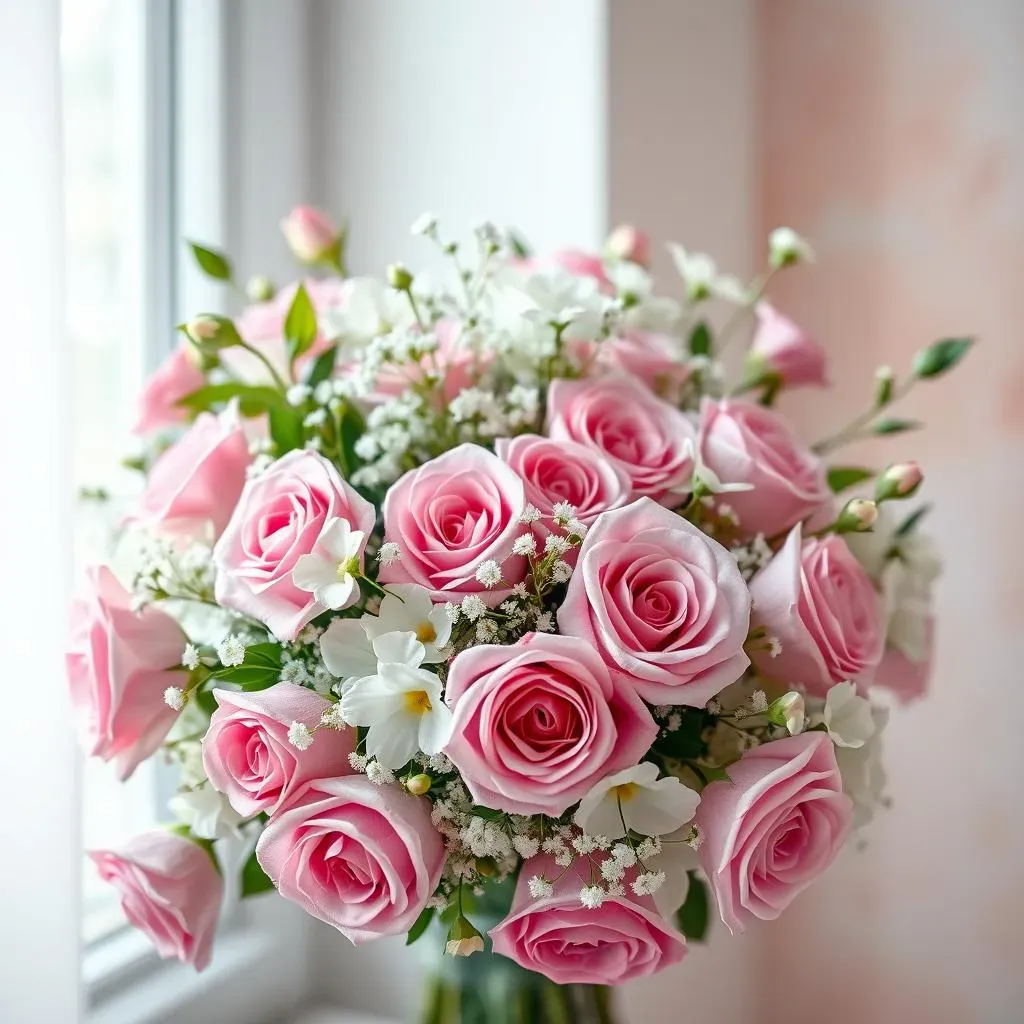
Choosing Complementary Blooms
While pink and white roses are undeniably beautiful on their own, incorporating other flowers can add depth, texture, and visual interest to your bouquet. Think about flowers that complement the soft hues of your roses, rather than competing with them. Delicate blooms like baby's breath, sweet peas, or lisianthus can create a romantic and ethereal feel, while slightly bolder flowers like ranunculus or peonies can add a touch of richness and texture. The key is to choose flowers that harmonize with your roses, creating a cohesive and visually appealing arrangement.
Consider the shape and size of the complementary flowers. Smaller blooms can fill in gaps between roses, creating a more full and lush bouquet. Larger blooms can be strategically placed to add pops of color or texture. Don’t be afraid to experiment with different textures as well. The combination of soft rose petals with the delicate texture of baby's breath or the slightly more rugged texture of eucalyptus can create a visually appealing contrast. Remember, the goal is to create a balanced and harmonious bouquet that is both beautiful and reflects your personal style.
Flower | Color Options | Texture |
|---|---|---|
Baby's Breath | White | Delicate, feathery |
Sweet Pea | Variety of pastel shades | Delicate, ruffled |
Lisianthus | White, pink, purple | Delicate, almost rose-like |
Ranunculus | Variety of colors, including pinks and whites | Full, layered petals |
Peony | Variety of colors, including pinks and whites | Large, full blooms |
Considering Seasonal Availability and Color Palettes
Seasonal availability plays a significant role in choosing your complementary flowers. Working with your florist, you can identify blooms that are in season and readily available during your wedding month. This ensures freshness and often better pricing. Consider the overall color palette of your wedding. Do you want to stick to a monochromatic scheme with varying shades of pink and white, or would you like to add a pop of color with a complementary shade like blush peach, soft lavender, or even a touch of greenery? The choice is yours, but make sure the colors harmonize well and enhance the beauty of your roses.
For example, if your wedding is in spring, you might consider incorporating tulips or daffodils in shades that complement your roses. In summer, hydrangeas or gardenias could add a touch of lushness and fragrance. For a fall wedding, dahlias or asters might be excellent choices. Remember to always discuss your vision with your florist. They can offer expert advice on which flowers are best suited to your chosen style, your wedding theme, and the season of your wedding. Their expertise is invaluable in ensuring that your bouquet is not only beautiful but also practical and long-lasting.
- Consider seasonal availability for freshness and cost-effectiveness.
- Choose a color palette that complements your roses and wedding theme.
- Discuss your vision with your florist for expert advice.
Adding Greenery for Depth and Texture
Don't underestimate the power of greenery in enhancing your pink and white rose bouquet! Greenery adds depth, texture, and visual interest, helping to create a more balanced and harmonious arrangement. Eucalyptus, ferns, and seeded eucalyptus are popular choices, offering varying shades of green and interesting textures. These can be woven throughout the bouquet, creating a natural and elegant look. The right greenery can also help to highlight the beauty of your roses, rather than competing for attention. Think of it as a supporting cast, enhancing the main characters (your roses!)
Consider the shape and size of the greenery you choose. Smaller sprigs of greenery can fill in gaps and add a touch of delicate texture, while larger leaves can be used to create visual interest and contrast. The color of the greenery should also complement the overall color scheme of your bouquet. Shades of silver-green or dusty green can create a soft and romantic feel, while deeper greens can add a touch of richness and drama. Remember, the goal is to create a balanced and visually appealing arrangement that is both beautiful and reflects your personal style.
Preserving Your Beautiful Pink and White Rose Wedding Bouquet
Preserving Your Beautiful Pink and White Rose Wedding Bouquet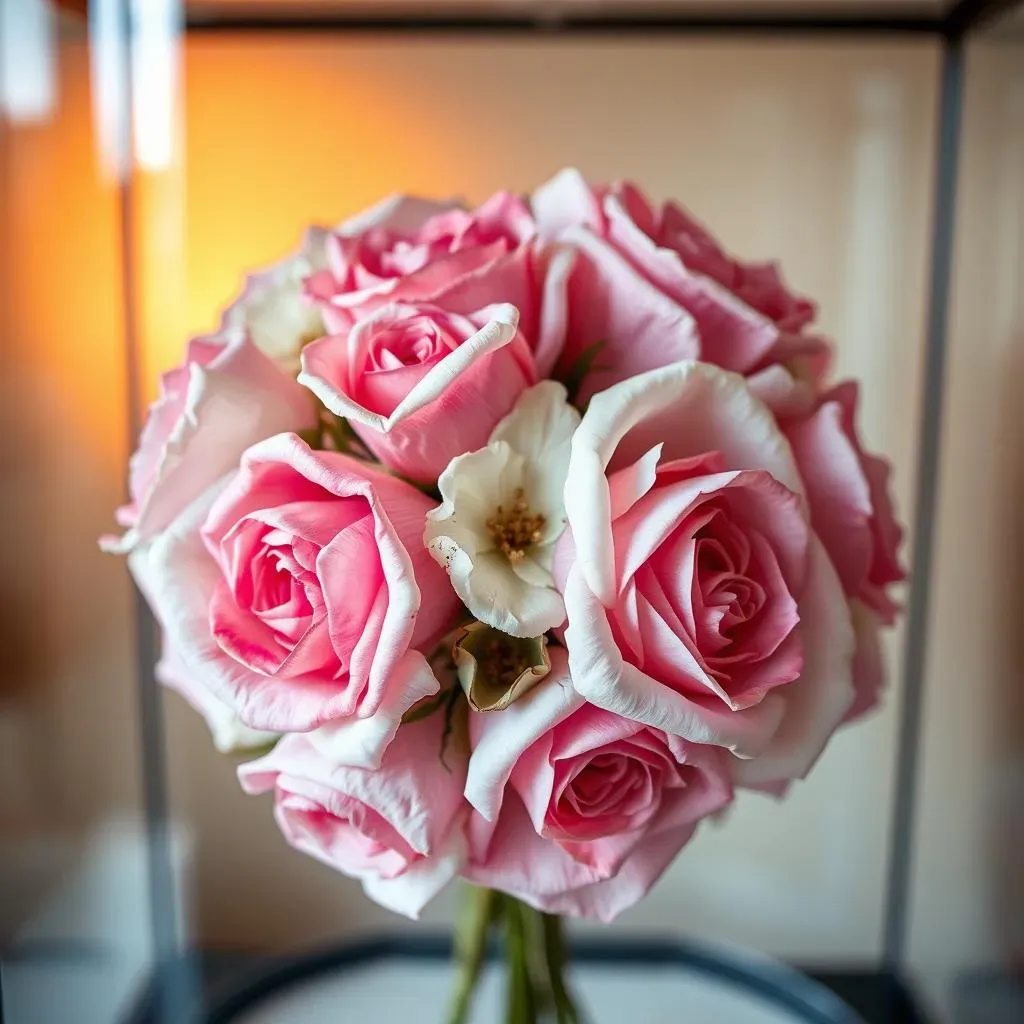
Methods for Preserving Your Bouquet
So, your amazing pink and white rose wedding bouquet has arrived, and you want to keep its memory alive. There are several ways to do this, each with its own pros and cons. Air drying is the simplest method. Simply hang your bouquet upside down in a cool, dark, and dry place for several weeks. This is a great option for preserving the shape and color of the flowers, although the petals will become brittle. Pressing is another popular method, ideal for creating a flat, two-dimensional keepsake. Place your flowers between sheets of blotting paper inside a heavy book for several weeks. This method works best for smaller, flatter flowers. Finally, you can have your bouquet professionally preserved. This is the most expensive option but guarantees the best results, with your flowers retaining their color, shape, and texture for years to come.
Consider your budget and the level of detail you want to preserve when choosing a method. Air-drying is budget-friendly but results in more fragile flowers. Pressing is also inexpensive but gives you a different look. Professional preservation is expensive but maintains the bouquet's original beauty. No matter which method you choose, remember to handle your bouquet gently to avoid damaging the flowers.
Preservation Method | Pros | Cons |
|---|---|---|
Air Drying | Simple, inexpensive | Flowers become brittle |
Pressing | Simple, inexpensive, creates a flat keepsake | Only suitable for flatter flowers |
Professional Preservation | Best results, long-lasting | Expensive |
Creating Lasting Memories with Your Preserved Bouquet
Once your bouquet is preserved, you'll want to display it proudly! There are many creative ways to showcase your beautiful keepsake. A simple and elegant option is to place it in a clear glass dome or shadow box. This allows you to admire the flowers from all angles. You could also incorporate it into a larger display, such as a wedding memory album or a shadow box containing other wedding mementos. Perhaps you'd like to frame a pressed bouquet, either on its own or within a larger piece of artwork. Alternatively, consider using the preserved flowers in a unique craft project, such as creating a resin paperweight or incorporating them into a decorative wreath.
Think about your personal style and your home décor when choosing a way to display your bouquet. Consider where it will be displayed and how it will look in that space. Will it be a focal point or a more subtle accent? The possibilities are endless, so let your creativity guide you. Remember, the goal is to create a lasting memory of your special day, so choose a display method that feels meaningful and personal to you. No matter how you choose to display it, your preserved bouquet will serve as a constant reminder of your beautiful wedding day.
- Display in a glass dome or shadow box
- Incorporate into a wedding memory album or shadow box
- Frame a pressed bouquet
- Use in a craft project (resin paperweight, decorative wreath)
Tips and Tricks for Preserving Your Bouquet
To ensure your bouquet lasts as long as possible, there are a few things you can do. If air drying, make sure the area is well-ventilated to prevent mold growth. For pressing, use high-quality blotting paper and change it regularly to absorb excess moisture. If opting for professional preservation, choose a reputable company with experience in preserving flowers. Always handle your bouquet with care to avoid damaging the delicate petals. Avoid direct sunlight or heat, as this can cause the colors to fade. Proper care and attention will ensure your beautiful pink and white rose wedding bouquet remains a cherished reminder of your special day for years to come.
Remember, preserving your wedding bouquet is a personal journey, a way to hold onto the memories and emotions of your wedding day. Whether you choose a simple air-drying method or a professional preservation service, the most important thing is that you choose a method that feels right for you and allows you to cherish your bouquet for years to come. The process of preserving your bouquet is as special as the day itself; enjoy the experience!
